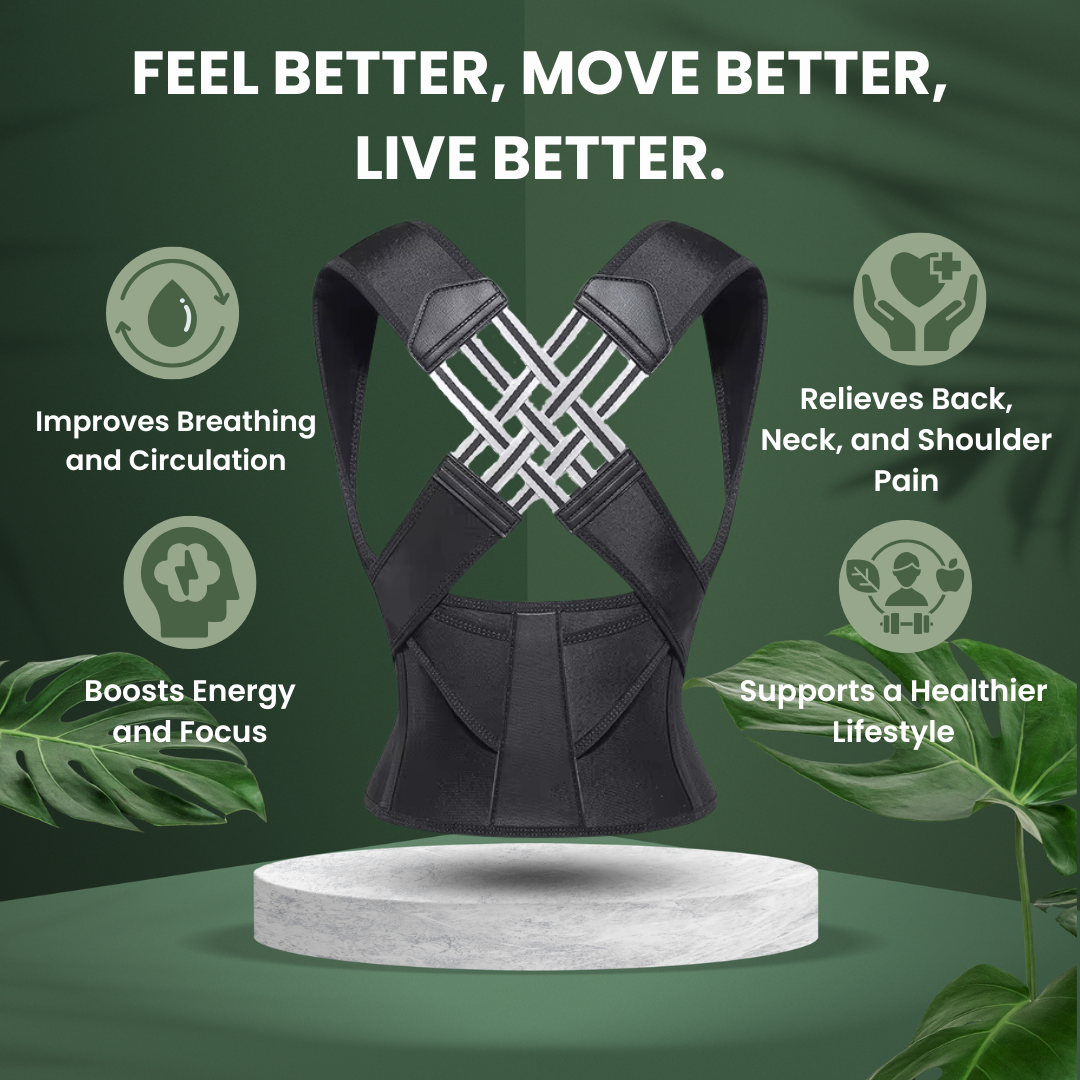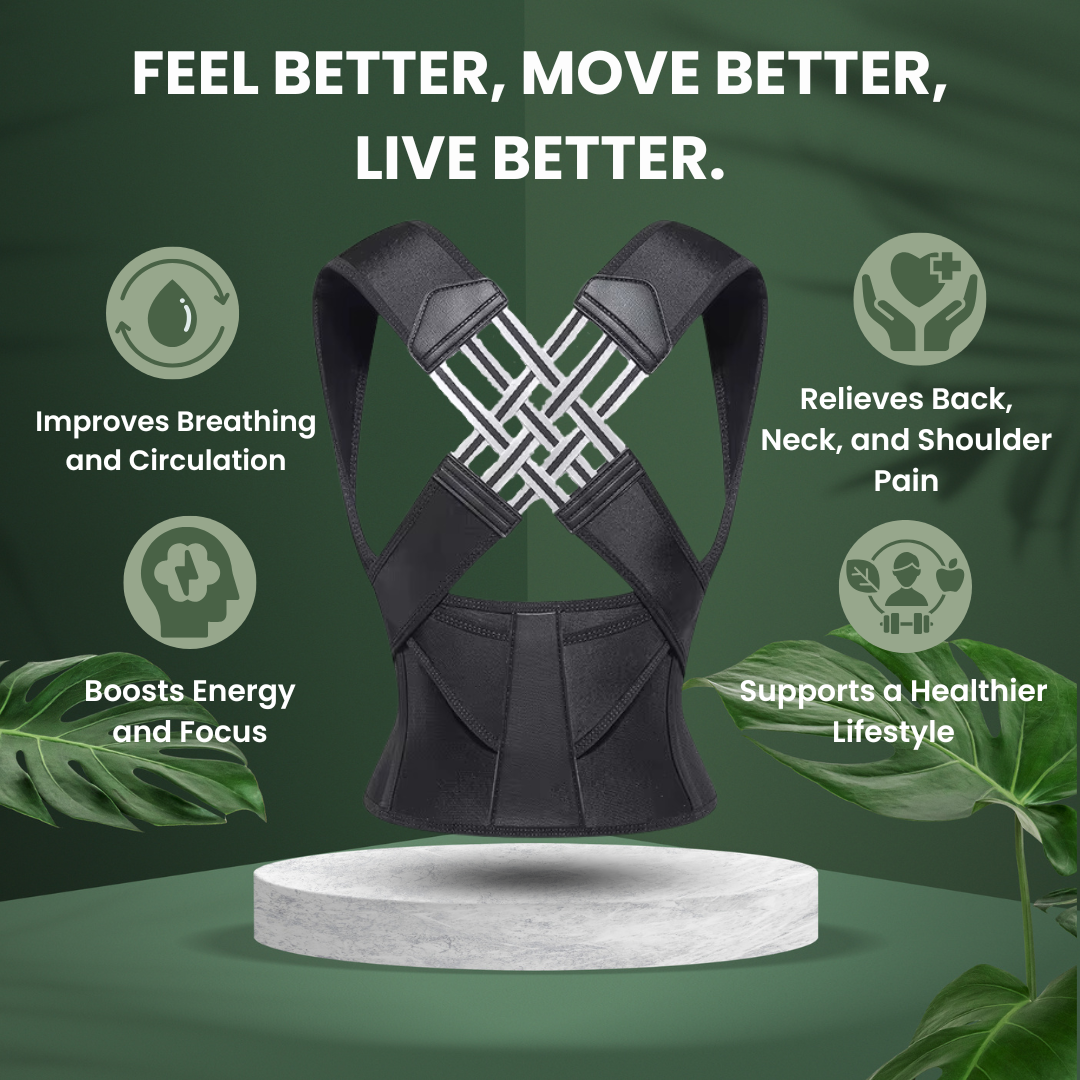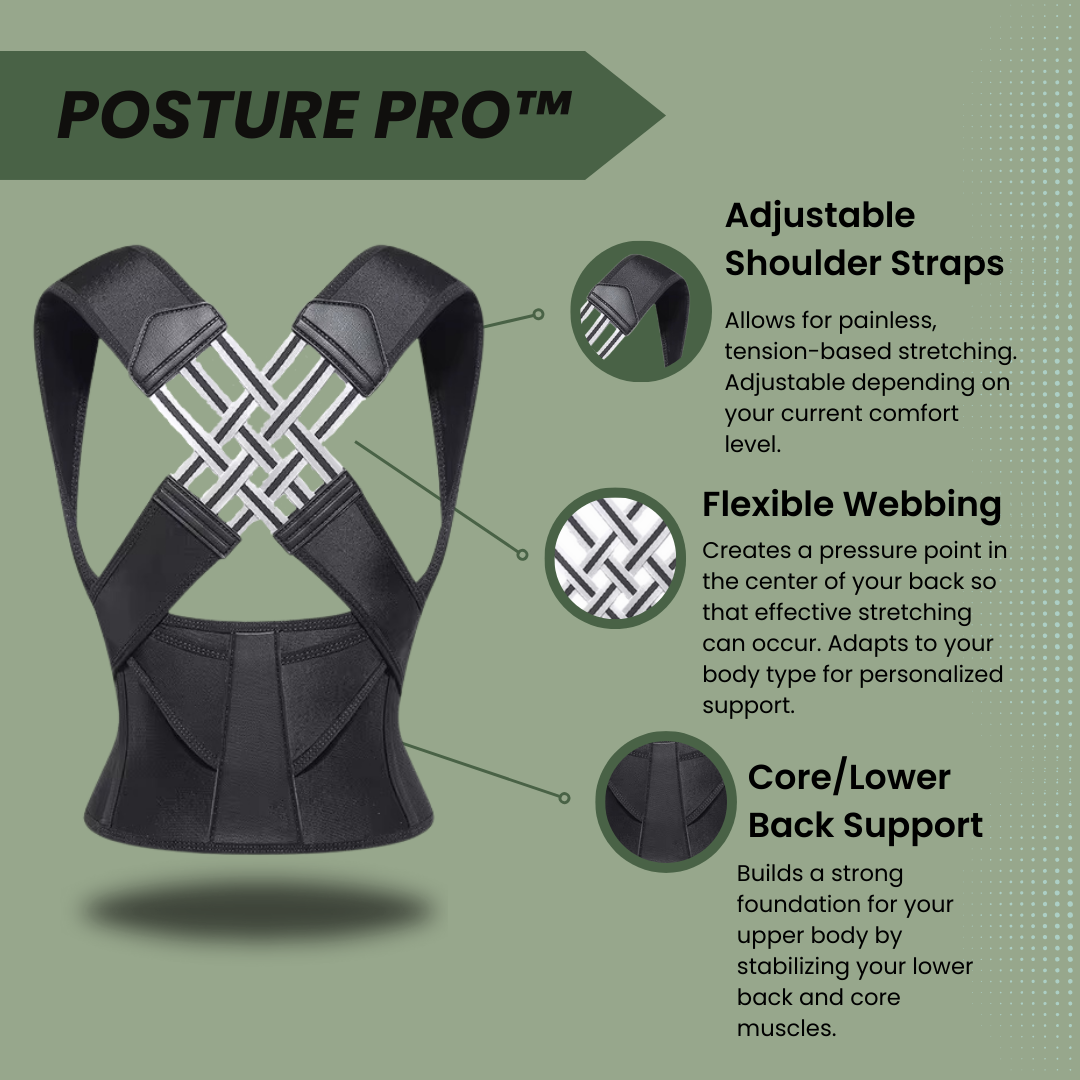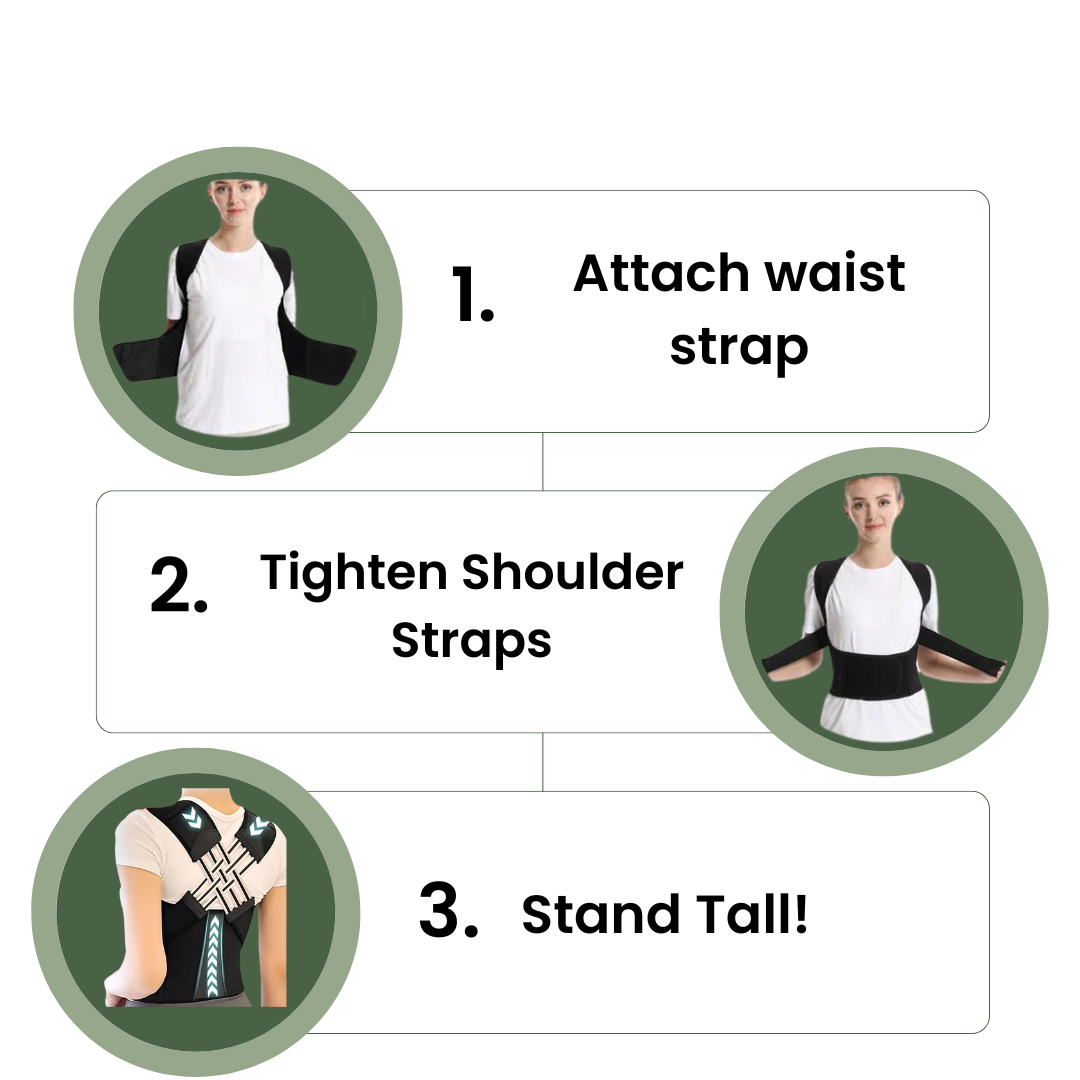Many people struggle with back pain every day. One key fact is that good posture can reduce this discomfort. This article will show you the physical benefits of correct posture and how it improves your life.
Keep reading to find out more!
Key Takeaways
- Correct posture reduces stress on bones and joints, which lessens aches and pains while improving joint health for smoother movement.
- Maintaining good posture strengthens core muscles, leading to increased stability, better balance, easier breathing, and reduced risk of injury.
- Good alignment supports the spine's natural curve, enhancing respiratory function and overall well-being through improved mood, confidence, and productivity.
The Power of Good Posture
Good posture reduces stress on your bones and joints. It also strengthens your core muscles, leading to improved overall health.
Less stress on bones and joints
Correct posture reduces stress on bones and joints. By maintaining proper body alignment, you distribute your weight evenly over your feet. This balance prevents unnecessary strain on your musculoskeletal system.
Less strain leads to fewer aches and pains in the spine and neck. Improved alignment also supports joint health, allowing for smoother movements.
Individuals with good posture often experience reduced back pain and increased energy levels. They can engage in daily activities without discomfort or fatigue. A strong core plays a crucial role here, providing stability to the spine during movement.
Maintaining this strength improves overall physical health and enhances daily performance.
Good posture is essential for overall health.
Strengthen core muscles
Good posture plays a critical role in strengthening core muscles. It helps to keep the spine aligned and supports proper body mechanics during various activities. Strong core muscles stabilize the body, which enhances balance and stability.
This foundation reduces stress on bones and joints while preventing common aches and pains.
Engaging the core through posture correction boosts overall muscle strength. A strong core allows for easier movement, better breathing, and improved mood. Individuals with strong cores experience reduced risk of injury, especially when lifting heavy objects or remaining active throughout the day.
Prioritizing good posture can lead to long-term spinal health and increased energy levels.
Easier breathing
Correct posture significantly improves breathing. It allows your lungs to fully expand. With proper body alignment, you create more space for your diaphragm to work effectively. This increased lung capacity leads to better oxygen intake and circulation throughout the body.
Poor posture can restrict airflow and hinder energy levels. Slouching compresses the chest and makes it difficult to breathe deeply. Practicing good posture not only promotes easier breathing but also boosts overall well-being, including improved mood and productivity.
Improved spine and neck health
Good posture greatly enhances spine and neck health. It supports the natural curve of the spine, which helps prevent common aches and pains. Maintaining correct body alignment reduces stress on these areas.
This can lead to decreased back pain and increased energy levels throughout the day.
Proper posture also promotes better breathing. Improved respiratory function benefits overall well-being. Stronger core muscles support the spine further, boosting confidence and improving mood.
Taking care of your posture is vital for long-term health, ensuring a strong musculoskeletal system that can handle daily activities with ease.
Benefits of Correct Posture

Good posture boosts your confidence and enhances your mood. It can also increase your energy levels throughout the day. Standing tall reduces the risk of injury, making you feel more capable in daily tasks.
Improved posture even helps you stay productive as you focus better on your work. Discover how correct posture can transform your life!
Increased confidence
Correct posture boosts confidence significantly. Standing tall and aligned sends a strong message to others. This positive body language impacts how people perceive you. Good posture enhances your presence in social and professional settings.
It also improves spine health, which plays a part in overall well-being.
Moreover, good alignment helps reduce discomfort from aches and pains. With less physical stress, individuals often feel more energized and focused. Better energy levels can lead to improved mood as well.
As confidence grows, so does productivity at work or school. Practicing good body alignment doesn't just help you stand better; it strengthens your core muscles too, leading to an enhanced sense of self-assurance.
More energy
Good posture increases energy levels. It allows the body to function better. Proper alignment helps balance weight over the feet. This reduces strain on muscles and joints, preventing fatigue.
Good posture also supports the spine, which can reduce back pain. Improved breathing plays a role too. Deep breaths provide more oxygen, fueling energy throughout the day. Maintaining strong core muscles makes this easier.
Overall, good posture boosts productivity and keeps you feeling energized daily.
Better mood
Good posture can significantly boost your mood. It helps maintain proper body alignment, which supports the spine and reduces discomfort. This reduction in aches can lead to fewer distractions throughout the day.
As a result, you focus better and feel more energized.
A positive position also increases self-confidence. Standing tall makes you appear more assertive and engaged. This confidence boost brightens your outlook on life. Ultimately, correct posture fosters a healthier mindset and enhances overall well-being.
Reduced risk of injury
Correct posture significantly reduces the risk of injury. Balance allows the body's weight to distribute evenly over the feet. This alignment supports the spine and helps prevent common aches and pains.
Maintaining good body alignment also aids in different movements and activities, which can lower strain on muscles. Strong core strength plays a vital role in stabilizing your body during physical tasks, reducing potential injuries from falls or improper lifting techniques.
Improved neck and spine health contributes to better overall function, making daily tasks easier and safer. Prioritizing correct posture is essential for long-term health and well-being.
Boosted productivity
Good posture enhances productivity in many ways. It allows the body to function efficiently, which helps maintain focus and energy. People who practice good posture often feel less fatigued throughout the day.
Balanced weight over the feet supports overall stability and coordination during tasks. This alignment reduces discomfort and common aches that can distract from work.
Improved spine and neck health also play a role in boosting productivity. Individuals who sit or stand correctly are less likely to experience pain, which allows them to concentrate better on their activities.
A strong core contributes to better body support during movement, allowing for increased stamina during long hours at work or school. Investing time in proper body alignment pays off by improving performance and making daily tasks easier as well as more enjoyable.
Exercises to Improve Posture
Exercises to improve posture help strengthen muscles and enhance overall body alignment. They target specific areas like the back and shoulders, promoting a healthier stance. Try these workouts consistently for the best results.
Discover how simple changes can lead to significant improvements in your comfort and health.
For desk workers
Desk workers often face challenges with posture. Poor posture can lead to discomfort and fatigue.
- Maintain a straight back while sitting. This action supports the spine and helps prevent common aches and pains.
- Plant feet flat on the ground. Doing this balances the body’s weight over the feet, reducing strain on joints.
- Adjust chair height to keep knees at a 90-degree angle. Proper alignment increases comfort and prevents injury.
- Use an ergonomic chair that supports lower back curves. Good support can enhance overall physical health.
- Position the computer screen at eye level. Keeping screens aligned reduces neck strain and promotes better posture.
- Take breaks every hour to stretch muscles. Short breaks help maintain energy levels throughout the day.
- Incorporate simple stretches while seated, such as shoulder rolls or neck tilts. These movements combat stiffness and improve mood.
- Stay aware of your posture during video calls or meetings. Good posture boosts confidence, making you appear more engaged.
Good posture matters for desk workers' physical well-being. Correct alignment leads to increased productivity and improved mental focus.
For drivers
Good posture is essential for drivers. It enhances comfort and keeps energy levels high during long trips.
- Sit straight with your back against the seat. This position helps support the spine and can prevent common aches and pains.
- Adjust your seat so that your knees stay level with your hips. This alignment reduces stress on your joints.
- Keep both feet flat on the floor or foot pedals. A stable base aids in better control of the vehicle.
- Position the steering wheel at chest height. This adjustment allows for easier movement and better handling, reducing fatigue.
- Use a lumbar support pillow if needed. Proper support for the lower back will improve overall spine health while driving.
- Shift positions frequently during long drives. Changing your posture can help maintain energy levels and reduce stiffness.
- Take breaks to stretch every hour or so. Stretching contributes to better body alignment and helps keep you focused on the road.
- Stay aware of how you hold your neck while driving. Good neck health ties directly into overall well-being and reduces discomfort.
- Maintain an ergonomic layout for your controls within reach, ensuring safe access without straining to reach them.
Practicing good posture while driving benefits both physical health and performance behind the wheel, making it vital for long-term well-being on the road.
For those on their feet all day
Standing for long periods can cause fatigue and discomfort. Correct posture can help alleviate these issues.
- Balance your body weight over your feet to promote stability. This approach can reduce strain on your back and joints.
- Support your spine with proper alignment while standing. This support can prevent common aches and pains, leading to better overall health.
- Engage your core muscles to improve strength. Strong core muscles provide better support for your body during movement.
- Maintain an open chest to facilitate easier breathing. Proper breathing enhances oxygen flow and boosts energy levels.
- Shift your weight from one foot to the other periodically. This practice helps reduce fatigue by relieving pressure on specific muscles and joints.
- Wear supportive footwear designed for comfort during long hours of standing. Comfortable shoes play a vital role in maintaining good posture.
- Take breaks when possible to sit or stretch your legs. These breaks contribute to reducing stress on bones and joints throughout the day.
- Stay mindful of your posture at all times, even while walking or moving around. Good posture supports all types of activities, promoting better overall well-being.
Correct posture is essential for anyone on their feet all day, contributing greatly to physical health and productivity in daily tasks as outlined in "The Physical Benefits of Correct Posture: Why Good Posture Matters.
For those who do heavy lifting
Good posture plays a crucial role in heavy lifting. It can help prevent injuries and improve overall performance.
- Keep your feet shoulder-width apart to maintain balance. This stance helps distribute weight evenly, reducing strain on the body.
- Bend at your knees and hips instead of your back when lifting. Proper bending protects your spine and prevents common aches and pains.
- Engage your core muscles during lifting. A strong core stabilizes your body, which supports the spine during heavy movements.
- Hold the object close to your body while lifting. This technique minimizes stress on joints and enhances control over the lift.
- Lift with your legs, not your back. Strong leg muscles can handle more weight, decreasing the risk of back pain and injury.
- Maintain an upright position as you lift. Good posture allows for easier breathing and boosts energy levels throughout the task.
- Avoid twisting your torso when carrying objects. Twisting can lead to injury; staying aligned keeps you safe.
- Take breaks during long periods of heavy lifting. Regular breaks help reduce fatigue and support long-term health.
Conclusion
Correct posture significantly impacts your health. It helps balance your body's weight and supports the spine. This support reduces back pain and boosts energy levels. Strong posture increases confidence and improves mood.
Embrace good alignment for better overall well-being.
FAQs
1. What is ergonomics and how does it relate to posture?
Ergonomics is the study of people's efficiency in their working environment. It includes maintaining correct posture for physical health.
2. Why does good posture matter?
Good posture matters because it helps keep bones and joints in correct alignment, reducing stress on muscles and ligaments.
3. How can ergonomics help improve my posture?
Ergonomic design ensures workspaces are comfortable and promote good posture, reducing the risk of back pain or muscle strain.
4. Can poor posture be corrected with ergonomic practices?
Yes! Incorporating ergonomic practices into your daily routine can greatly improve your overall body alignment, leading to better health outcomes.



















